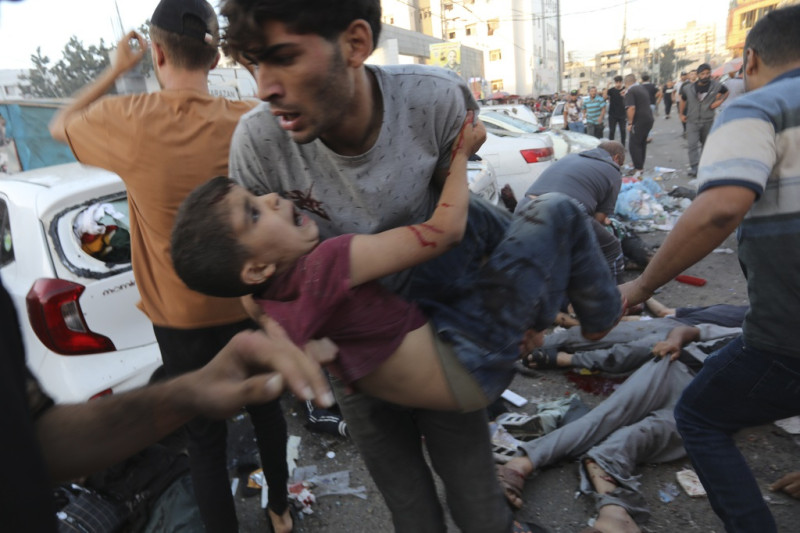Some 23,300 people, mostly women and children, have been killed in the Gaza Strip and 60,000 injured, while thousands remain trapped in the rubble, according to Hamas.
Families grieving in morgues, one population exhausted, terrifiedneighborhoods transformed into ruins, health system in collapse… the war between Israel and Hamas has ravaged the Gaza Strip.
“It’s only been a hundred days, but it feels like a hundred years,” says Abdulaziz Saadat, who, like almost all the residents, has fled his home and lives in a makeshift camp in Rafah, where the nights are bitterly cold.
The small densely populated coastal enclave is unrecognizable. Entire, usually bustling, districts have been reduced to ruins.
“Some live in schools, others on the streets, in the dirt, and others sleep on benches. No one has escaped the war,” says Saadat. Nearly 1.9 million residents, 80% of the population, have fled their homes, according to the UN.
“Death and Despair”
The Gaza Strip has become uninhabited, a place of death and despair,” says UN Humanitarian Coordinator Martin Griffiths.
However, 2.4 million Palestinians are still surviving as best they can. Few, a few hundred, have managed to get out of the enclave that has been cordoned off since the Israeli bombardment began on October 7.
Some 23,300 people, mostly women and children, have been killed in the Gaza Strip and 60,000 have been injured, while thousands remain trapped in the rubble, according to Hamas.
Refugee camps, roads and passes are littered with craters. Schools, universities, places of religious worship have been hit.
Israel accuses Hamas of waging war using the Palestinian population as a shield and schools, religious sites and hospitals as launching pads.
Mass disasters
Using satellite imagery, two American academics, Jamon Van Den Heck and Corey Scher, have deduced that 45% to 56% of buildings in the Gaza Strip have been destroyed or damaged.
The disasters “are very widespread and fast,” according to Van Den Heck. The scale of the devastation “is comparable to the devastation in the worst-hit areas of Ukraine,” says Corey Sher.
According to a study by the United Nations Satellite Center (UNOSAT), 18% of buildings were destroyed or damaged after 50 days of war.
The end of the conflict would not mean for the people of Gaza a return to their homes, and the task of reconstruction is expected to be titanic.
Historic buildings have been hit, mainly in the maze of narrow streets of Gaza’s historic center, where Al Omari, the oldest mosque in the Palestinian enclave, was also destroyed.
Even after the guns have fallen silent, the dead will haunt the place. Due to lack of space in cemeteries, mass graves have been dug in flower beds, in hospital yards, in football fields.
When they do make it to a hospital that is still functioning (only 15 out of 36), the wounded discover another battlefield, according to Rick Pieperkorn of the World Health Organization in the occupied Palestinian territories.
In the hospitals he managed to visit, he describes the “chaos”, “blood on the floor”, the voices of the wounded who wait even days to receive care. Some operating theaters are lit with smartphones and operations are sometimes performed without anesthesia.
“There are shortages of almost all medical materials,” says the representative of the World Health Organization who “has never seen so many mutilations in his life.”
On the brink of famine
“We have lost all hope,” says Ibrahim Saadat. “Because of the lack of water, we only bathe once a month, we suffer mentally, and diseases have spread everywhere.”
According to Unicef, cases of diarrhea in children rose from 48,000 to 71,000 in one month, before the war, it reached 2,000 a month.
“In 30 years, I have never seen such massive food shortages,” says Corinne Fleischer, regional director of the World Food Programme.
“Food production has completely stopped and people can’t go to the fields or fish in the sea,” he explains. The port of Gaza, where fishermen used to unload the day’s catch from their colorful boats, has been bombed.
Cultivated lands, known mainly for winter strawberries, are not accessible.
Many furnaces have been destroyed or closed due to lack of fuel. Desperate residents climb onto trucks carrying humanitarian aid to find food.
“The stores are empty, there’s nothing to buy to eat,” says Corinne Fleischer.
Beyond the hardships, the terror, the destruction, 23-year-old Hadid Shehata talks about the despair of the youth of the Palestinian enclave, where half the population is under 18 years old. “Children can lose many years of their lives living here. Some went to school, others to kindergarten… All this was of no use, all was lost. We lost all our dreams.”
Source :Skai
With a wealth of experience honed over 4+ years in journalism, I bring a seasoned voice to the world of news. Currently, I work as a freelance writer and editor, always seeking new opportunities to tell compelling stories in the field of world news.











